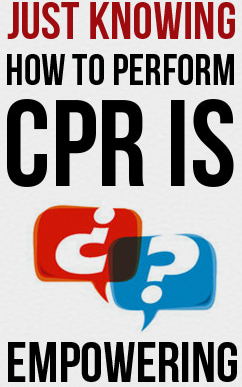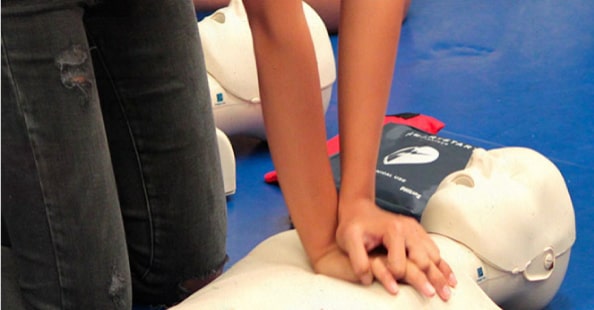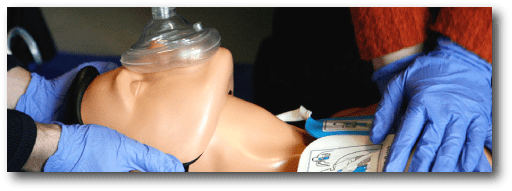
Why You Should Consider Getting
CPR Training Today
If you’re like most people, you probably have multiple stories to tell about times your skills came in handy unexpectedly. Maybe your boss’s computer went on the fritz and you were theonly one in the office that knew how to fix it thanks to a computer class you took in college. Maybe your first job was as a suit salesman and, later on in life, you were able to use what you learned to help your best friend pick out the perfect tux for his wedding. Life can be unpredictable that way.
Now imagine you knew how to save someone’s life by performing lifesaving CPR. How useful would a skill like that be if life handed you the opportunity to use it? The fact of the matter is, CPR (short for cardio-pulmonary resuscitation) can be learned by anyone when they sign up for
a simple, easy training course. It’s also potentially one of the most valuable skills you could ever acquire. The following are just a few of the reasons why signing up for official training is something you should consider.
CPR really does save lives

You don’t have to be a medical professional in order for CPR to come in handy as a skill. You’re a lot more likely to come in contact with someone who isn’t breathing or whose heart has stopped beating than you think. More than 300,000 people in the United States suffer cardiacarr ests every single year, and each can potentially benefit from receiving CPR.
When a person goes into sudden cardiac arrest, their heart stops beating, and they can suddenly collapse without warning. They may quickly lose consciousness and stop breathing. The longer that person goes without blood circulation, the lower their overall chance of survival becomes.
If you can perform CPR on that person, then you can help their blood keep circulating while you wait for emergency medical personnel to arrive. When CPR is started early enough, it doubles someone’s chances of surviving a sudden cardiac arrest.

When you picture a situation in public that sees a person collapsing from cardiac arrest, what do you figure happens? Do you picture at least one or two bystanders immediately running to the person’s side to start performing CPR immediately? If so, then you’d be very wrong.
According to national statistics, only 15-30% of cardiac arrest sufferers ever receive CPR at the hands of a bystander – much less than half of all cases. When bystanders are asked why they didn’t at least attempt to perform CPR, the most common answer by far is that they haven’t received CPR training and weren’t comfortable performing CPR without it.
If you’ve never received CPR training, then the chances are pretty good that you’d be afraid to perform CPR yourself for the same reasons. You might be worried about hurting the person or hurting yourself. You might be concerned about legal repercussions. Such worries often disappear once proper training is received.
 That said, imagine how great it would feel to know that you could do something to help someone else if you ever found yourself in such a situation. Why not be the bystander who is able to say you know what to do? You could easily wind up being the reason someone lived to see another day.
That said, imagine how great it would feel to know that you could do something to help someone else if you ever found yourself in such a situation. Why not be the bystander who is able to say you know what to do? You could easily wind up being the reason someone lived to see another day.
It’s important to realize that CPR doesn’t just save the lives of strangers, either. Wouldn’t you like to know that if your spouse, best friend, parent, or child needed CPR, you’d be able to potentially save their life as well?
Speaking of children, CPR is considered to be an especially good skill for parents to know, especially if their children are younger than five years old. Children that young tend to put objects in their mouths more often, and many children can wind up choking as a result. Once the
blockage is removed, the child will need CPR if they’re still not breathing.

If someone in your family has a cardiac arrest in their lifetime, the chances are pretty good that it will happen at home, as opposed to out in public somewhere. Numbers like that make it a whole lot more important that as many people as possible learn CPR. Any one of us really might wind
up being the one who is called upon to save a loved one, guest, or acquaintance by performing CPR.
Doctors everywhere can tell stories they’ve heard from patients all about how their lives were saved because their wife, friend, child, or parent reacted quickly by performing life-saving CPR. In fact, CPR is considered to be such a critical skill that the American Heart Association is pushing to have it taught in schools.
You don’t necessarily have to perform
mouth-to-mouth
Another common reason people give for not taking the initiative to perform CPR, especially on a stranger, is concern about giving mouth-to-mouth resuscitation. Some are worried about the possibility of infection. Others simply aren’t comfortable for personal reasons.
If you can relate to that, then you should know that in 2010, the official guidelines for performing CPR were changed. They now say that someone who hasn’t received formal training or isn’t comfortable with mouth-to-mouth for any reason can attempt hands-only CPR instead. Hands-only CPR can be just as effective in many cases of cardiac arrest, and it’s definitely preferable to doing nothing at all.
You could team up with another person
who also knows CPR
Even in the event you’re not the only one in a given situation who knows CPR, your being trained can still greatly increase the person’s chances of surviving. CPR is easier to perform, not to mention more effective, when two people team up and perform it together.
This is an excellent reason why receiving CPR training makes a great group endeavor. Consider talking your entire family into signing up with you or getting your circle of friends together to do it as a group. You’ll all be able to rest assured in the knowledge that you would know what to do
to help one another if any of you needed CPR. You would also easily be able to team up to increase a victim’s chances of survival. Many training facilities offer special group rates, so you collectively save money by learning together.


When some people picture taking a CPR training class, they picture something like their college English class – a course that will take months of commitment and study to complete. In actuality, most CPR training classes are only an hour or two long, so you don’t have to clear multiple
afternoons a week for months at a time in order to learn it.
CPR training isn’t just fast, either. It’s also affordable on even a modest budget. It’s incredibly convenient, as well. These days, you can receive fully certified CPR training online. All you need is an hour or so of free time and an internet connection to learn to save a life right now.
Receiving official training increases your chances of
performing CPR properly
No, CPR is not terribly hard to learn. In fact, most people probably already know the bare basics if they’ve ever seen a fictional character perform CPR on television or in a movie. However, receiving bona fide training so that you’re truly prepared is a much better option than assuming
you’d know what to do because you’ve seen it on Grey’s Anatomy.
Proper training increases the potential effectiveness of CPR considerably. As touched on above, it also helps to eliminate some of the fears, anxiety, and reservations that come alongside being faced with a true life-or-death situation. For instance, training drastically reduces the chances of performing the procedure improperly. You’re reducing the already slim chance of facing legal repercussions.
CPR training classes
teach you more than just CPR

CPR training is about a lot more than just learning the technique (although that’s certainly a big part of it). You’ll be taught everything you need to know to do a great job of handling a situation where CPR might be required.
You’ll learn how to check an emergency scene and properly assess the needs of the person in possible need of CPR. You’ll learn when to call 911 and how to spot the signs of choking, heart attack, and other common issues that might accompany a CPR-appropriate situation. Many CPR courses will teach you basic first aid skills as well – like how to control bleeding, treat insect stings, handle snakebite, and more.
You can potentially gain an advantage
when it comes to your job
There are more employers out there that would consider it advantageous to have someone on staff trained in CPR than you might think. Of course, some jobs and career paths will require CPR certification before you’d be eligible. However, many others will look highly favorably on it.
CPR certification is considered a major plus if you’re applying for jobs that involve watching over other people in any capacity. Examples include personal trainer, lifeguard, grade school teacher, or child care provider. It’s not uncommon for those in customer service positions like retail or food service to gain an advantage because of CPR training.
All things considered, the above reasons are just the tip of the iceberg as far as why it would benefit you to receive CPR training. CPR truly is one of those skills that none of us can really afford to be without. Ultimately, it’s just too important, because of how many lives it saves already, and because of how many more it could save if more people knew how to perform it.
Receiving
CPR Training

When it comes to getting your CPR training, you have a number of options available to you. If you prefer taking a class in person, start by checking out what opportunities are available to you in your community. Many local hospitals, community centers, and health care clinics have
programs that support CPR training, so they can often point you in the right direction.
Online CPR training is also a popular option. It’s more convenient for many people these days, as they can fit the class into their schedule whenever it works for them. It’s even possible to receive official CPR certification as required by many employers via online courses.
Choosing the
Right Course for You
CPR classes aren’t necessarily one-size-fits-all, so make sure you evaluate your options carefully once you start looking at what’s available. There are basic options available, of course. However, many training facilities will also offer blended learning options that offer additional value.
For instance, there are specialized courses that teach you specific techniques to use on infants or young children. As touched on above, many combine CPR techniques with training on basic first aid practices that are often equally as useful. Specialized CPR training authorities will even offer career-specific classes for healthcare providers and other professionals.

Time commitments and prices can also vary from course to course, so make sure you’re clear on what a given class involves before you sign up. Remember, CPR courses are not full-blown multi-month commitments, so, on average, they only require an hour or two of your time. However, classes that teach additional skills or are intended for professional purposes may take several hours. If that will be an issue, ask about splitting the course up into several shorter sessions.
Getting Your
Certification
If you are looking to obtain an official CPR certification – especially if you’re doing it for employment reasons — it’s incredibly important to make sure that the training option you choose will be able to provide that. Some course providers will simply offer a certificate that merely shows you’ve been trained. This isn’t the same thing.
Once you have your certification, it’s important to know when it expires. (Most are good for two years.) That said, it’s a good idea to consider the refresher classes you will also need going forward when choosing an initial training provider. Some will offer free digital skill refreshers that help you keep your certification up to date. Explore your options today!















